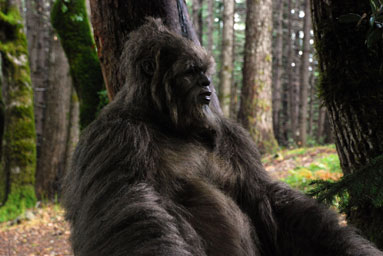
Field & Screen
GENEROUS SUPPORT FOR
FIELD & SCREEN 2012 CAME FROM A GRANT FROM THE
Puffin Foundation West, Ltd.
Introduced by the director on Feb 24
(Christopher Munch, 2011)
Fri, Feb 24–Sat, Feb 25, 2012 | 7:00PM
Film/Video Theater
Letters from the Big Man is the eagerly anticipated latest film from one of American independent film’s unsung auteurs.
Lily Rabe plays an artist/hydrologist who finds herself in Oregon’s Klamath National Forest trying to balance a recent break-up with the politics of deforestation and a burgeoning love with a sasquatch. Instead of playing the premise for laughs, Munch examines the ancient and spiritual beauty of the region and people unaffected by the last ice age. (105 mins., video)
NY TIMES REVIEW
In the Deep Forest, an Unusual Bond and Untamed Beauty
By MANOHLA DARGIS
In his poem “The Way West, Underground,” from his collection “Turtle Island,” Gary Snyder writes vividly of “The split-cedar/smoked salmon/cloudy days of Oregon,/ the thick fir forests.” The book’s title refers to an indigenous creation story in which North America emerged from some soil placed on the back of a turtle by a woman who fell from the sky. In some versions of the story a muskrat helps her. The woman in Christopher Munch’s lovely, delightfully idiosyncratic “Letters From the Big Man,” resplendent with its own dense forests and cloudy Oregon days, has already fallen to earth and is looking for a way back up or maybe just forward. She gets help from a sasquatch.
That would be the Big Man (Isaac C. Singleton Jr., fantastically kitted out in fur and makeup), one of the more eccentric characters recently to hit the Big Screen. By virtue of his mythological status (um, perhaps), the Big Man is decidedly a more unusual movie presence than the woman, Sarah, though she too is unusual. A strong presence strongly played by Lily Rabe, Sarah, a former United States Forest Service employee, is the type of independent woman who, in American cinema, has moved off the threatened and onto the endangered list. Through many miles, narrative switchbacks, a drib of politics, a drab of shamanism, she and the Big Man develop a beautiful friendship.
The movie opens with Sarah packing up some belongings in an apartment and clearly leaving a man, seen with her in a photo, and a life behind. She tosses what she wants in a truck that she has adorned with primitive decorations, chucks the rest of her stuff and drives out of the city and into the woods. Mr. Munch, whose earlier films include “The Hours and Times,” handles this efficiently. But he doesn’t reveal what a splendid eye he has until he switches to some aerial shots of Sarah driving on a road that winds like a ribbon through a forest, a point of view that suggests that of an eagle — thereby introducing the idea of nonhuman perspectives — and underscores her isolation.
She isn’t alone for long, although she seems to ache, at times almost irritably, for solitude. There is a stop at a ranger station, where she borrows a kayak from an old friend, Penny (Fiona Dourif). Leaving her truck and friend behind, Sarah paddles off on a swift river, a sometimes perilous-looking voyage that signals her resolve and athleticism (and recklessness: she isn’t wearing a helmet), and shifts the movie into a sustained pastoral register.
What beauty Mr. Munch finds between the sheltering sky and rushing water. As he and his wizardly crew (including the cinematographer Rob Sweeney, expertly working in digital) bring the vibrantly hued landscape, dappled in greens, reds and gold, alive on screen, Sarah becomes just one part of what is clearly a much bigger picture.
Sarah ditches the boat and slips into the woods with such visible confidence that it’s apparent that this is where she belongs. (Mr. Munch likes to put Ms. Rabe in short shorts, showing off strong, shapely legs that look as if they could run in an Ironwoman triathlon or snap a man in two.) Now a struggling artist, she is doing field research for her old employer in the wake of a fire. After a quiet interlude her solitude is interrupted by the two male characters who will vie for her attention for the rest of the story: a friendly hiker, Sean (Jason Butler Harner), who turns out to be an environmental activist, and a more rarefied interloper, a sasquatch, an elusive, transformative presence.
For a character in a character study, Sarah is something of a puzzle at first, and almost off-putting. When Penny hugs her goodbye, Sarah doesn’t hug back, and when she meets Sean, she shuns the usual niceties and instead asks if he has a weapon, before flashing her gun. (This doesn’t register as Freudian but prudent, especially given the drug gangs who set up shop in forests.) Later, after she leaves the woods, where she sensed a pair of eyes on her — and no wonder, sasquatch is on the watch — and moves into a secluded cabin elsewhere, she assumes a more distinct, ruggedly individualistic figure of the neo-frontierswoman, one who probably read the Transcendentalists in school and now generates her own electricity to run her laptop.
In “Walden,” Thoreau writes of a starving, exhausted man lost in the woods whose loneliness is relieved by “grotesque visions” that he takes to be real. The sasquatch in “Letters From the Big Man,” a beguiling, Buddha-like figure who occasionally enjoys a wild-thing tantrum, offers Sarah — starving, the movie suggests, like the rest of us — companionship of a type, as well as a new, moving way of being.
As the story unwinds, Mr. Munch piles on the plot, mixing in romance, American Indian mythology, environmental fights and a government conspiracy that would be narratively unsustainable if his generosity toward his characters, his seriousness and faith in his story, didn’t make it all seem perfectly reasonable. And funny: I wish, Sarah muses to the Big Man, I had a man like you. Maybe she does!
LETTERS FROM THE BIG MAN




